Business Values & Ethics: Managerial Approaches & NHS Drug Approval
VerifiedAdded on 2023/04/21
|14
|5752
|474
Report
AI Summary
This report analyzes managerial behavior through five ethical approaches: Utilitarian, Rights, Fairness/Justice, Common Good, and Virtue. It discusses how each approach supports the organization positively. The second part examines the NHS's drug approval process, focusing on clinical and cost-effectiveness for multiple sclerosis treatments, and whether cost-effectiveness criteria align with consequentialism or virtue ethics. The analysis considers resource allocation, health benefits, and ethical considerations in healthcare.
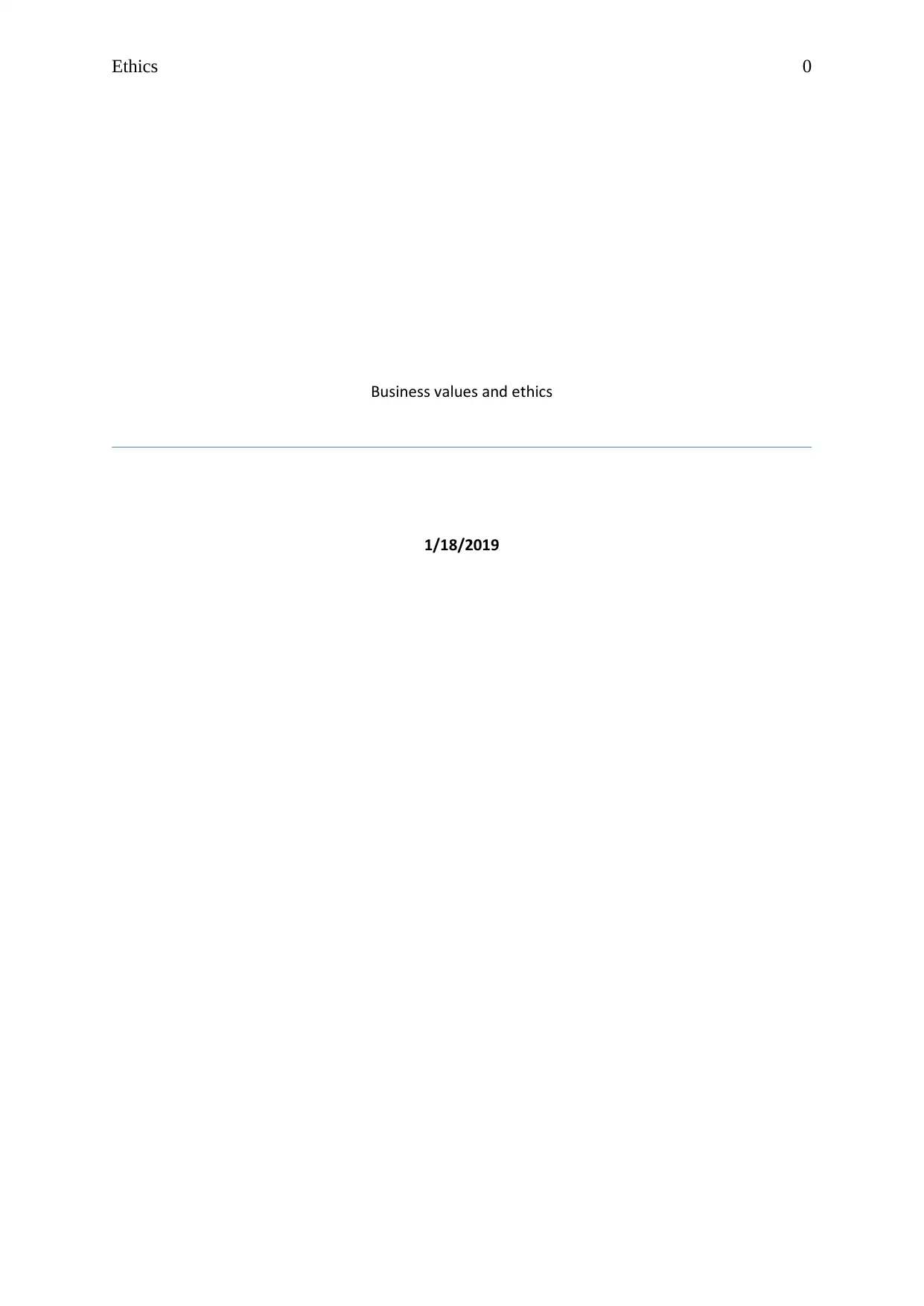
Ethics 0
Business values and ethics
1/18/2019
Business values and ethics
1/18/2019
Paraphrase This Document
Need a fresh take? Get an instant paraphrase of this document with our AI Paraphraser
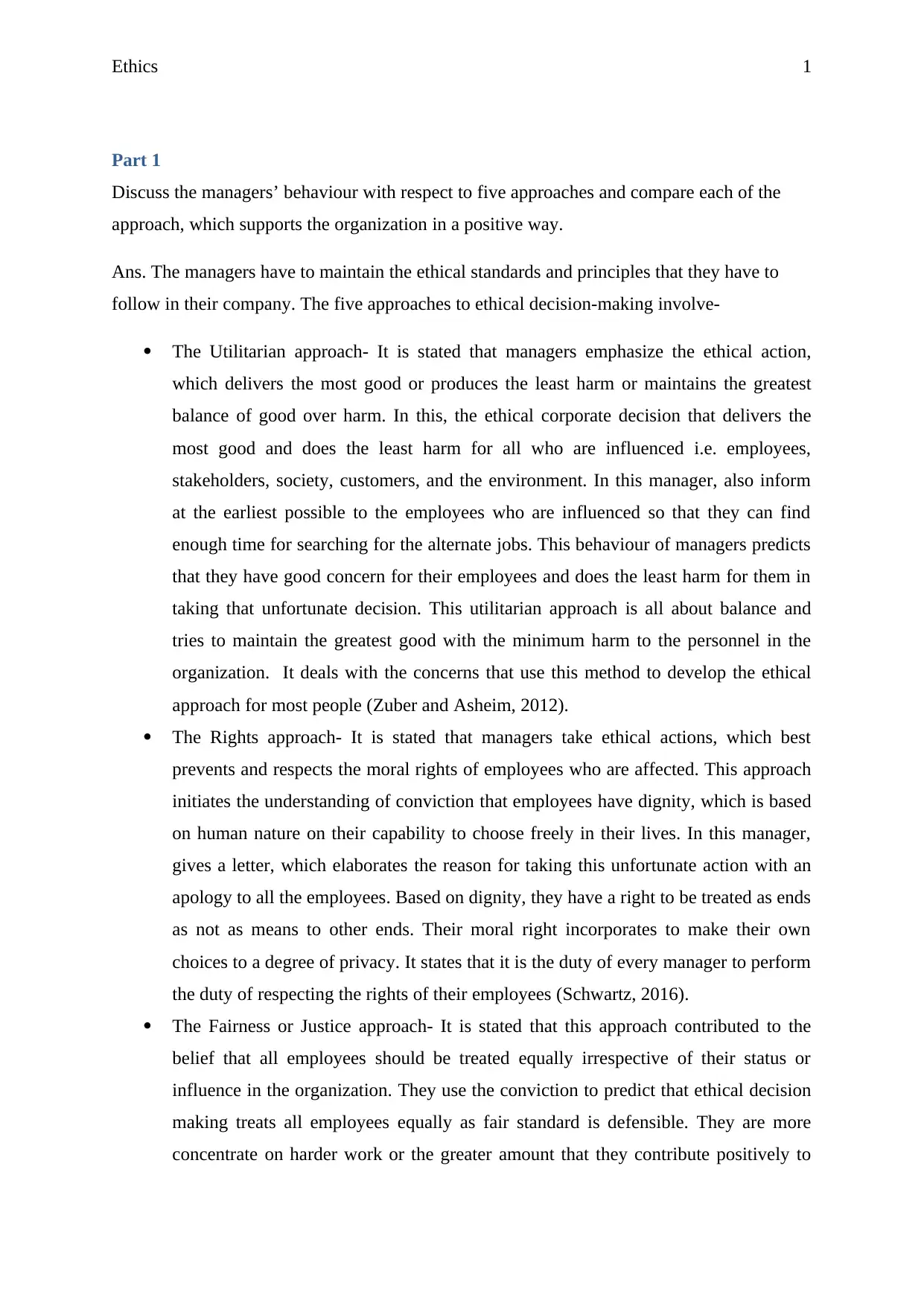
Ethics 1
Part 1
Discuss the managers’ behaviour with respect to five approaches and compare each of the
approach, which supports the organization in a positive way.
Ans. The managers have to maintain the ethical standards and principles that they have to
follow in their company. The five approaches to ethical decision-making involve-
The Utilitarian approach- It is stated that managers emphasize the ethical action,
which delivers the most good or produces the least harm or maintains the greatest
balance of good over harm. In this, the ethical corporate decision that delivers the
most good and does the least harm for all who are influenced i.e. employees,
stakeholders, society, customers, and the environment. In this manager, also inform
at the earliest possible to the employees who are influenced so that they can find
enough time for searching for the alternate jobs. This behaviour of managers predicts
that they have good concern for their employees and does the least harm for them in
taking that unfortunate decision. This utilitarian approach is all about balance and
tries to maintain the greatest good with the minimum harm to the personnel in the
organization. It deals with the concerns that use this method to develop the ethical
approach for most people (Zuber and Asheim, 2012).
The Rights approach- It is stated that managers take ethical actions, which best
prevents and respects the moral rights of employees who are affected. This approach
initiates the understanding of conviction that employees have dignity, which is based
on human nature on their capability to choose freely in their lives. In this manager,
gives a letter, which elaborates the reason for taking this unfortunate action with an
apology to all the employees. Based on dignity, they have a right to be treated as ends
as not as means to other ends. Their moral right incorporates to make their own
choices to a degree of privacy. It states that it is the duty of every manager to perform
the duty of respecting the rights of their employees (Schwartz, 2016).
The Fairness or Justice approach- It is stated that this approach contributed to the
belief that all employees should be treated equally irrespective of their status or
influence in the organization. They use the conviction to predict that ethical decision
making treats all employees equally as fair standard is defensible. They are more
concentrate on harder work or the greater amount that they contribute positively to
Part 1
Discuss the managers’ behaviour with respect to five approaches and compare each of the
approach, which supports the organization in a positive way.
Ans. The managers have to maintain the ethical standards and principles that they have to
follow in their company. The five approaches to ethical decision-making involve-
The Utilitarian approach- It is stated that managers emphasize the ethical action,
which delivers the most good or produces the least harm or maintains the greatest
balance of good over harm. In this, the ethical corporate decision that delivers the
most good and does the least harm for all who are influenced i.e. employees,
stakeholders, society, customers, and the environment. In this manager, also inform
at the earliest possible to the employees who are influenced so that they can find
enough time for searching for the alternate jobs. This behaviour of managers predicts
that they have good concern for their employees and does the least harm for them in
taking that unfortunate decision. This utilitarian approach is all about balance and
tries to maintain the greatest good with the minimum harm to the personnel in the
organization. It deals with the concerns that use this method to develop the ethical
approach for most people (Zuber and Asheim, 2012).
The Rights approach- It is stated that managers take ethical actions, which best
prevents and respects the moral rights of employees who are affected. This approach
initiates the understanding of conviction that employees have dignity, which is based
on human nature on their capability to choose freely in their lives. In this manager,
gives a letter, which elaborates the reason for taking this unfortunate action with an
apology to all the employees. Based on dignity, they have a right to be treated as ends
as not as means to other ends. Their moral right incorporates to make their own
choices to a degree of privacy. It states that it is the duty of every manager to perform
the duty of respecting the rights of their employees (Schwartz, 2016).
The Fairness or Justice approach- It is stated that this approach contributed to the
belief that all employees should be treated equally irrespective of their status or
influence in the organization. They use the conviction to predict that ethical decision
making treats all employees equally as fair standard is defensible. They are more
concentrate on harder work or the greater amount that they contribute positively to
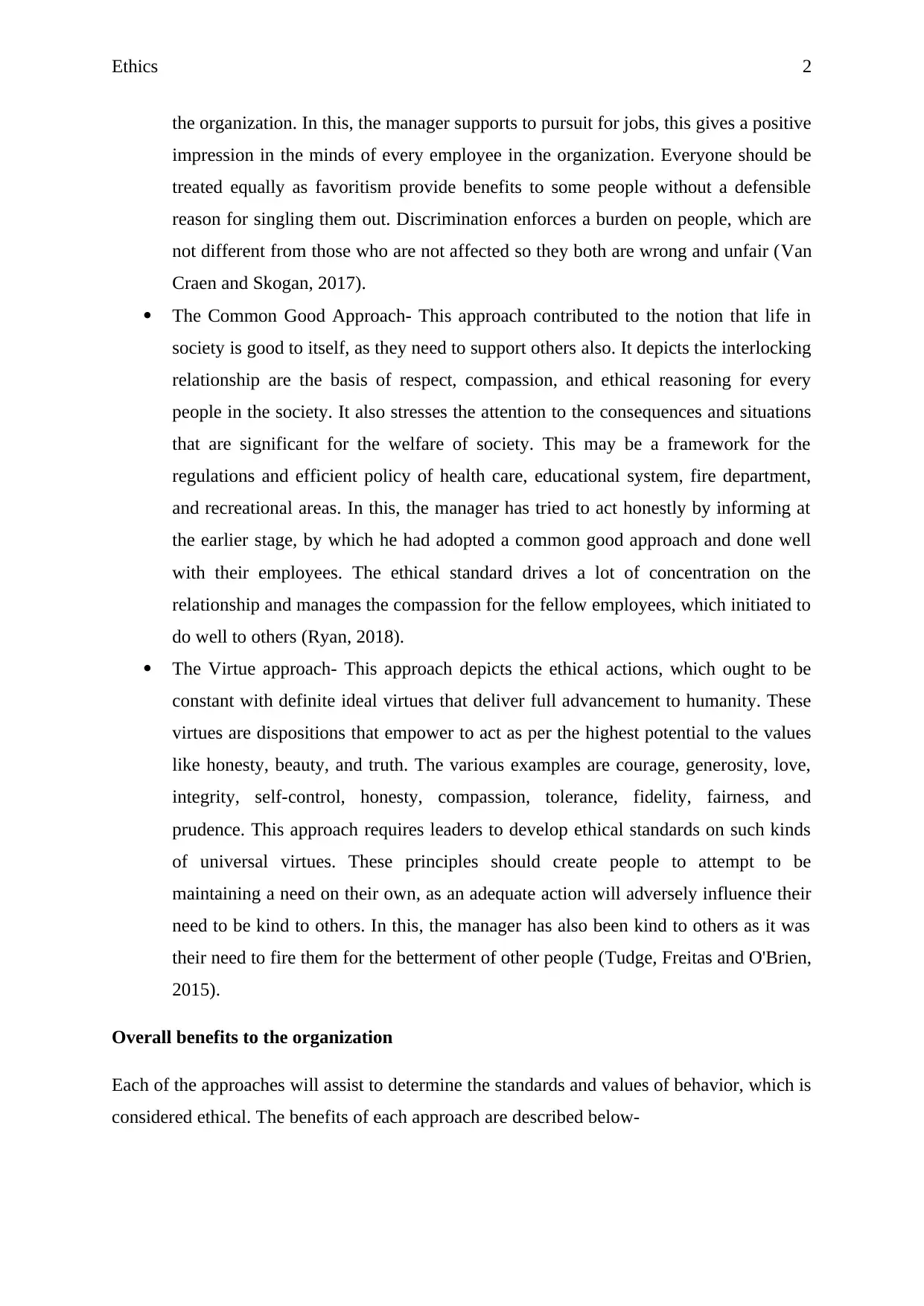
Ethics 2
the organization. In this, the manager supports to pursuit for jobs, this gives a positive
impression in the minds of every employee in the organization. Everyone should be
treated equally as favoritism provide benefits to some people without a defensible
reason for singling them out. Discrimination enforces a burden on people, which are
not different from those who are not affected so they both are wrong and unfair (Van
Craen and Skogan, 2017).
The Common Good Approach- This approach contributed to the notion that life in
society is good to itself, as they need to support others also. It depicts the interlocking
relationship are the basis of respect, compassion, and ethical reasoning for every
people in the society. It also stresses the attention to the consequences and situations
that are significant for the welfare of society. This may be a framework for the
regulations and efficient policy of health care, educational system, fire department,
and recreational areas. In this, the manager has tried to act honestly by informing at
the earlier stage, by which he had adopted a common good approach and done well
with their employees. The ethical standard drives a lot of concentration on the
relationship and manages the compassion for the fellow employees, which initiated to
do well to others (Ryan, 2018).
The Virtue approach- This approach depicts the ethical actions, which ought to be
constant with definite ideal virtues that deliver full advancement to humanity. These
virtues are dispositions that empower to act as per the highest potential to the values
like honesty, beauty, and truth. The various examples are courage, generosity, love,
integrity, self-control, honesty, compassion, tolerance, fidelity, fairness, and
prudence. This approach requires leaders to develop ethical standards on such kinds
of universal virtues. These principles should create people to attempt to be
maintaining a need on their own, as an adequate action will adversely influence their
need to be kind to others. In this, the manager has also been kind to others as it was
their need to fire them for the betterment of other people (Tudge, Freitas and O'Brien,
2015).
Overall benefits to the organization
Each of the approaches will assist to determine the standards and values of behavior, which is
considered ethical. The benefits of each approach are described below-
the organization. In this, the manager supports to pursuit for jobs, this gives a positive
impression in the minds of every employee in the organization. Everyone should be
treated equally as favoritism provide benefits to some people without a defensible
reason for singling them out. Discrimination enforces a burden on people, which are
not different from those who are not affected so they both are wrong and unfair (Van
Craen and Skogan, 2017).
The Common Good Approach- This approach contributed to the notion that life in
society is good to itself, as they need to support others also. It depicts the interlocking
relationship are the basis of respect, compassion, and ethical reasoning for every
people in the society. It also stresses the attention to the consequences and situations
that are significant for the welfare of society. This may be a framework for the
regulations and efficient policy of health care, educational system, fire department,
and recreational areas. In this, the manager has tried to act honestly by informing at
the earlier stage, by which he had adopted a common good approach and done well
with their employees. The ethical standard drives a lot of concentration on the
relationship and manages the compassion for the fellow employees, which initiated to
do well to others (Ryan, 2018).
The Virtue approach- This approach depicts the ethical actions, which ought to be
constant with definite ideal virtues that deliver full advancement to humanity. These
virtues are dispositions that empower to act as per the highest potential to the values
like honesty, beauty, and truth. The various examples are courage, generosity, love,
integrity, self-control, honesty, compassion, tolerance, fidelity, fairness, and
prudence. This approach requires leaders to develop ethical standards on such kinds
of universal virtues. These principles should create people to attempt to be
maintaining a need on their own, as an adequate action will adversely influence their
need to be kind to others. In this, the manager has also been kind to others as it was
their need to fire them for the betterment of other people (Tudge, Freitas and O'Brien,
2015).
Overall benefits to the organization
Each of the approaches will assist to determine the standards and values of behavior, which is
considered ethical. The benefits of each approach are described below-
⊘ This is a preview!⊘
Do you want full access?
Subscribe today to unlock all pages.

Trusted by 1+ million students worldwide
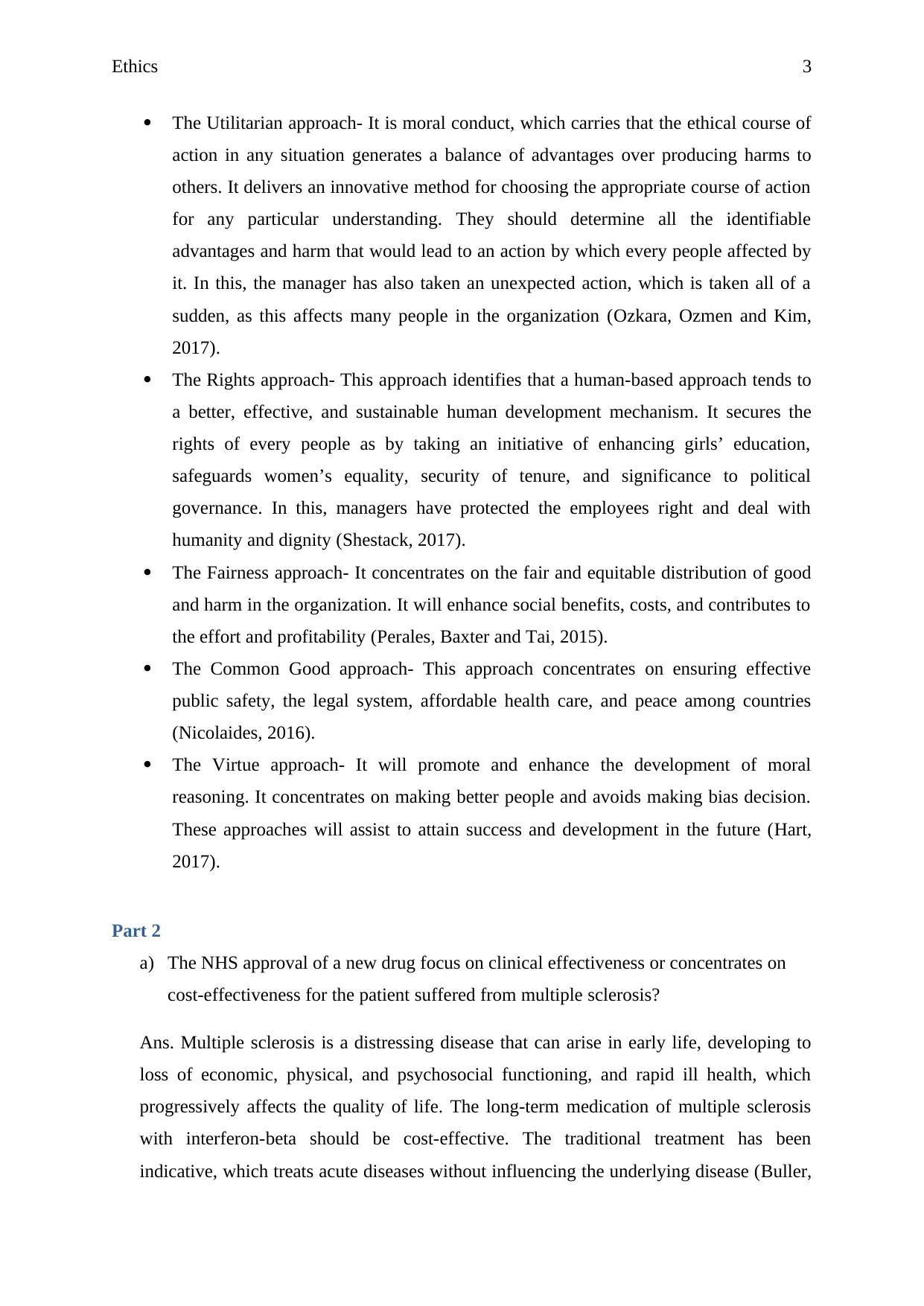
Ethics 3
The Utilitarian approach- It is moral conduct, which carries that the ethical course of
action in any situation generates a balance of advantages over producing harms to
others. It delivers an innovative method for choosing the appropriate course of action
for any particular understanding. They should determine all the identifiable
advantages and harm that would lead to an action by which every people affected by
it. In this, the manager has also taken an unexpected action, which is taken all of a
sudden, as this affects many people in the organization (Ozkara, Ozmen and Kim,
2017).
The Rights approach- This approach identifies that a human-based approach tends to
a better, effective, and sustainable human development mechanism. It secures the
rights of every people as by taking an initiative of enhancing girls’ education,
safeguards women’s equality, security of tenure, and significance to political
governance. In this, managers have protected the employees right and deal with
humanity and dignity (Shestack, 2017).
The Fairness approach- It concentrates on the fair and equitable distribution of good
and harm in the organization. It will enhance social benefits, costs, and contributes to
the effort and profitability (Perales, Baxter and Tai, 2015).
The Common Good approach- This approach concentrates on ensuring effective
public safety, the legal system, affordable health care, and peace among countries
(Nicolaides, 2016).
The Virtue approach- It will promote and enhance the development of moral
reasoning. It concentrates on making better people and avoids making bias decision.
These approaches will assist to attain success and development in the future (Hart,
2017).
Part 2
a) The NHS approval of a new drug focus on clinical effectiveness or concentrates on
cost-effectiveness for the patient suffered from multiple sclerosis?
Ans. Multiple sclerosis is a distressing disease that can arise in early life, developing to
loss of economic, physical, and psychosocial functioning, and rapid ill health, which
progressively affects the quality of life. The long-term medication of multiple sclerosis
with interferon-beta should be cost-effective. The traditional treatment has been
indicative, which treats acute diseases without influencing the underlying disease (Buller,
The Utilitarian approach- It is moral conduct, which carries that the ethical course of
action in any situation generates a balance of advantages over producing harms to
others. It delivers an innovative method for choosing the appropriate course of action
for any particular understanding. They should determine all the identifiable
advantages and harm that would lead to an action by which every people affected by
it. In this, the manager has also taken an unexpected action, which is taken all of a
sudden, as this affects many people in the organization (Ozkara, Ozmen and Kim,
2017).
The Rights approach- This approach identifies that a human-based approach tends to
a better, effective, and sustainable human development mechanism. It secures the
rights of every people as by taking an initiative of enhancing girls’ education,
safeguards women’s equality, security of tenure, and significance to political
governance. In this, managers have protected the employees right and deal with
humanity and dignity (Shestack, 2017).
The Fairness approach- It concentrates on the fair and equitable distribution of good
and harm in the organization. It will enhance social benefits, costs, and contributes to
the effort and profitability (Perales, Baxter and Tai, 2015).
The Common Good approach- This approach concentrates on ensuring effective
public safety, the legal system, affordable health care, and peace among countries
(Nicolaides, 2016).
The Virtue approach- It will promote and enhance the development of moral
reasoning. It concentrates on making better people and avoids making bias decision.
These approaches will assist to attain success and development in the future (Hart,
2017).
Part 2
a) The NHS approval of a new drug focus on clinical effectiveness or concentrates on
cost-effectiveness for the patient suffered from multiple sclerosis?
Ans. Multiple sclerosis is a distressing disease that can arise in early life, developing to
loss of economic, physical, and psychosocial functioning, and rapid ill health, which
progressively affects the quality of life. The long-term medication of multiple sclerosis
with interferon-beta should be cost-effective. The traditional treatment has been
indicative, which treats acute diseases without influencing the underlying disease (Buller,
Paraphrase This Document
Need a fresh take? Get an instant paraphrase of this document with our AI Paraphraser
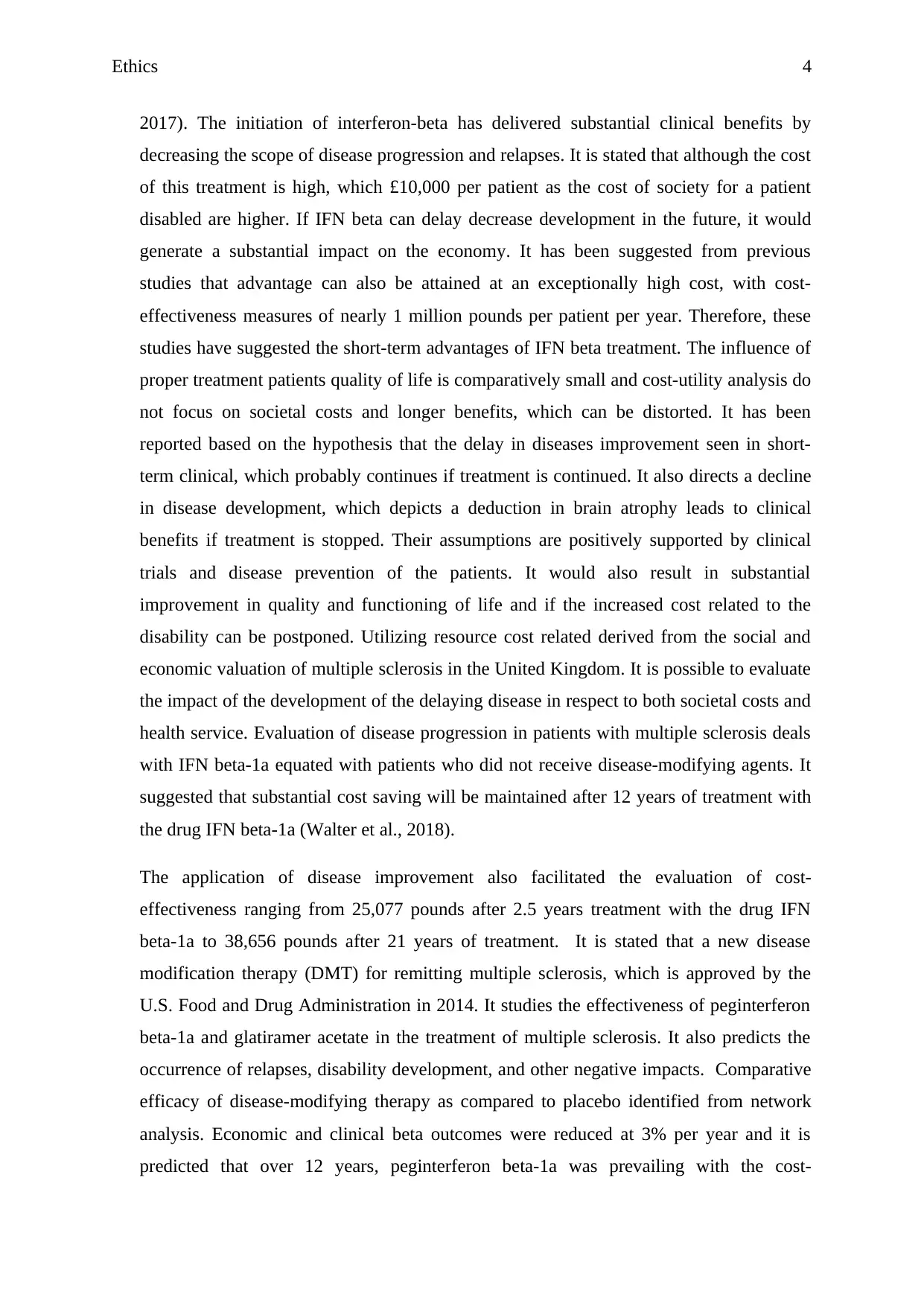
Ethics 4
2017). The initiation of interferon-beta has delivered substantial clinical benefits by
decreasing the scope of disease progression and relapses. It is stated that although the cost
of this treatment is high, which £10,000 per patient as the cost of society for a patient
disabled are higher. If IFN beta can delay decrease development in the future, it would
generate a substantial impact on the economy. It has been suggested from previous
studies that advantage can also be attained at an exceptionally high cost, with cost-
effectiveness measures of nearly 1 million pounds per patient per year. Therefore, these
studies have suggested the short-term advantages of IFN beta treatment. The influence of
proper treatment patients quality of life is comparatively small and cost-utility analysis do
not focus on societal costs and longer benefits, which can be distorted. It has been
reported based on the hypothesis that the delay in diseases improvement seen in short-
term clinical, which probably continues if treatment is continued. It also directs a decline
in disease development, which depicts a deduction in brain atrophy leads to clinical
benefits if treatment is stopped. Their assumptions are positively supported by clinical
trials and disease prevention of the patients. It would also result in substantial
improvement in quality and functioning of life and if the increased cost related to the
disability can be postponed. Utilizing resource cost related derived from the social and
economic valuation of multiple sclerosis in the United Kingdom. It is possible to evaluate
the impact of the development of the delaying disease in respect to both societal costs and
health service. Evaluation of disease progression in patients with multiple sclerosis deals
with IFN beta-1a equated with patients who did not receive disease-modifying agents. It
suggested that substantial cost saving will be maintained after 12 years of treatment with
the drug IFN beta-1a (Walter et al., 2018).
The application of disease improvement also facilitated the evaluation of cost-
effectiveness ranging from 25,077 pounds after 2.5 years treatment with the drug IFN
beta-1a to 38,656 pounds after 21 years of treatment. It is stated that a new disease
modification therapy (DMT) for remitting multiple sclerosis, which is approved by the
U.S. Food and Drug Administration in 2014. It studies the effectiveness of peginterferon
beta-1a and glatiramer acetate in the treatment of multiple sclerosis. It also predicts the
occurrence of relapses, disability development, and other negative impacts. Comparative
efficacy of disease-modifying therapy as compared to placebo identified from network
analysis. Economic and clinical beta outcomes were reduced at 3% per year and it is
predicted that over 12 years, peginterferon beta-1a was prevailing with the cost-
2017). The initiation of interferon-beta has delivered substantial clinical benefits by
decreasing the scope of disease progression and relapses. It is stated that although the cost
of this treatment is high, which £10,000 per patient as the cost of society for a patient
disabled are higher. If IFN beta can delay decrease development in the future, it would
generate a substantial impact on the economy. It has been suggested from previous
studies that advantage can also be attained at an exceptionally high cost, with cost-
effectiveness measures of nearly 1 million pounds per patient per year. Therefore, these
studies have suggested the short-term advantages of IFN beta treatment. The influence of
proper treatment patients quality of life is comparatively small and cost-utility analysis do
not focus on societal costs and longer benefits, which can be distorted. It has been
reported based on the hypothesis that the delay in diseases improvement seen in short-
term clinical, which probably continues if treatment is continued. It also directs a decline
in disease development, which depicts a deduction in brain atrophy leads to clinical
benefits if treatment is stopped. Their assumptions are positively supported by clinical
trials and disease prevention of the patients. It would also result in substantial
improvement in quality and functioning of life and if the increased cost related to the
disability can be postponed. Utilizing resource cost related derived from the social and
economic valuation of multiple sclerosis in the United Kingdom. It is possible to evaluate
the impact of the development of the delaying disease in respect to both societal costs and
health service. Evaluation of disease progression in patients with multiple sclerosis deals
with IFN beta-1a equated with patients who did not receive disease-modifying agents. It
suggested that substantial cost saving will be maintained after 12 years of treatment with
the drug IFN beta-1a (Walter et al., 2018).
The application of disease improvement also facilitated the evaluation of cost-
effectiveness ranging from 25,077 pounds after 2.5 years treatment with the drug IFN
beta-1a to 38,656 pounds after 21 years of treatment. It is stated that a new disease
modification therapy (DMT) for remitting multiple sclerosis, which is approved by the
U.S. Food and Drug Administration in 2014. It studies the effectiveness of peginterferon
beta-1a and glatiramer acetate in the treatment of multiple sclerosis. It also predicts the
occurrence of relapses, disability development, and other negative impacts. Comparative
efficacy of disease-modifying therapy as compared to placebo identified from network
analysis. Economic and clinical beta outcomes were reduced at 3% per year and it is
predicted that over 12 years, peginterferon beta-1a was prevailing with the cost-
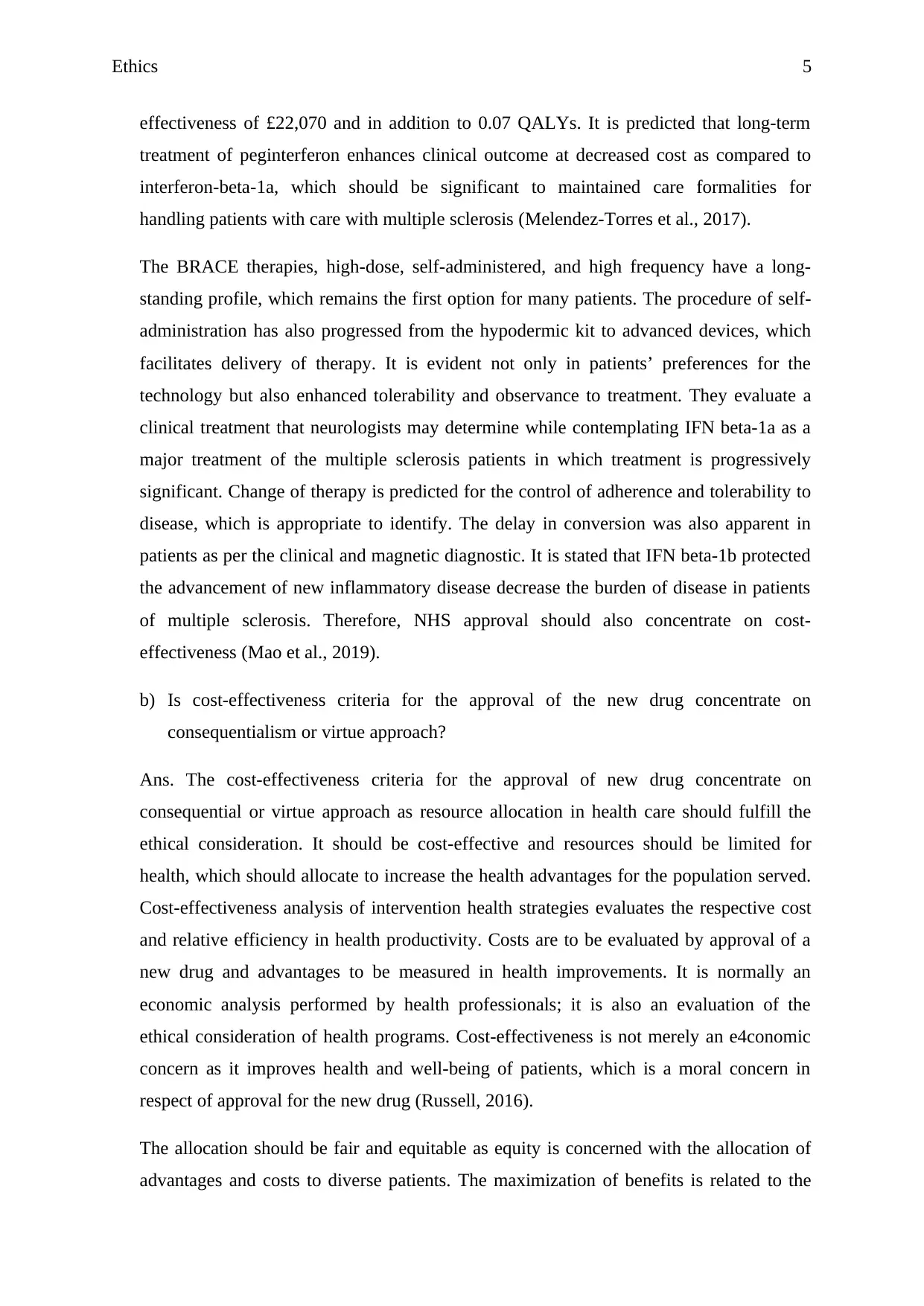
Ethics 5
effectiveness of £22,070 and in addition to 0.07 QALYs. It is predicted that long-term
treatment of peginterferon enhances clinical outcome at decreased cost as compared to
interferon-beta-1a, which should be significant to maintained care formalities for
handling patients with care with multiple sclerosis (Melendez-Torres et al., 2017).
The BRACE therapies, high-dose, self-administered, and high frequency have a long-
standing profile, which remains the first option for many patients. The procedure of self-
administration has also progressed from the hypodermic kit to advanced devices, which
facilitates delivery of therapy. It is evident not only in patients’ preferences for the
technology but also enhanced tolerability and observance to treatment. They evaluate a
clinical treatment that neurologists may determine while contemplating IFN beta-1a as a
major treatment of the multiple sclerosis patients in which treatment is progressively
significant. Change of therapy is predicted for the control of adherence and tolerability to
disease, which is appropriate to identify. The delay in conversion was also apparent in
patients as per the clinical and magnetic diagnostic. It is stated that IFN beta-1b protected
the advancement of new inflammatory disease decrease the burden of disease in patients
of multiple sclerosis. Therefore, NHS approval should also concentrate on cost-
effectiveness (Mao et al., 2019).
b) Is cost-effectiveness criteria for the approval of the new drug concentrate on
consequentialism or virtue approach?
Ans. The cost-effectiveness criteria for the approval of new drug concentrate on
consequential or virtue approach as resource allocation in health care should fulfill the
ethical consideration. It should be cost-effective and resources should be limited for
health, which should allocate to increase the health advantages for the population served.
Cost-effectiveness analysis of intervention health strategies evaluates the respective cost
and relative efficiency in health productivity. Costs are to be evaluated by approval of a
new drug and advantages to be measured in health improvements. It is normally an
economic analysis performed by health professionals; it is also an evaluation of the
ethical consideration of health programs. Cost-effectiveness is not merely an e4conomic
concern as it improves health and well-being of patients, which is a moral concern in
respect of approval for the new drug (Russell, 2016).
The allocation should be fair and equitable as equity is concerned with the allocation of
advantages and costs to diverse patients. The maximization of benefits is related to the
effectiveness of £22,070 and in addition to 0.07 QALYs. It is predicted that long-term
treatment of peginterferon enhances clinical outcome at decreased cost as compared to
interferon-beta-1a, which should be significant to maintained care formalities for
handling patients with care with multiple sclerosis (Melendez-Torres et al., 2017).
The BRACE therapies, high-dose, self-administered, and high frequency have a long-
standing profile, which remains the first option for many patients. The procedure of self-
administration has also progressed from the hypodermic kit to advanced devices, which
facilitates delivery of therapy. It is evident not only in patients’ preferences for the
technology but also enhanced tolerability and observance to treatment. They evaluate a
clinical treatment that neurologists may determine while contemplating IFN beta-1a as a
major treatment of the multiple sclerosis patients in which treatment is progressively
significant. Change of therapy is predicted for the control of adherence and tolerability to
disease, which is appropriate to identify. The delay in conversion was also apparent in
patients as per the clinical and magnetic diagnostic. It is stated that IFN beta-1b protected
the advancement of new inflammatory disease decrease the burden of disease in patients
of multiple sclerosis. Therefore, NHS approval should also concentrate on cost-
effectiveness (Mao et al., 2019).
b) Is cost-effectiveness criteria for the approval of the new drug concentrate on
consequentialism or virtue approach?
Ans. The cost-effectiveness criteria for the approval of new drug concentrate on
consequential or virtue approach as resource allocation in health care should fulfill the
ethical consideration. It should be cost-effective and resources should be limited for
health, which should allocate to increase the health advantages for the population served.
Cost-effectiveness analysis of intervention health strategies evaluates the respective cost
and relative efficiency in health productivity. Costs are to be evaluated by approval of a
new drug and advantages to be measured in health improvements. It is normally an
economic analysis performed by health professionals; it is also an evaluation of the
ethical consideration of health programs. Cost-effectiveness is not merely an e4conomic
concern as it improves health and well-being of patients, which is a moral concern in
respect of approval for the new drug (Russell, 2016).
The allocation should be fair and equitable as equity is concerned with the allocation of
advantages and costs to diverse patients. The maximization of benefits is related to the
⊘ This is a preview!⊘
Do you want full access?
Subscribe today to unlock all pages.

Trusted by 1+ million students worldwide
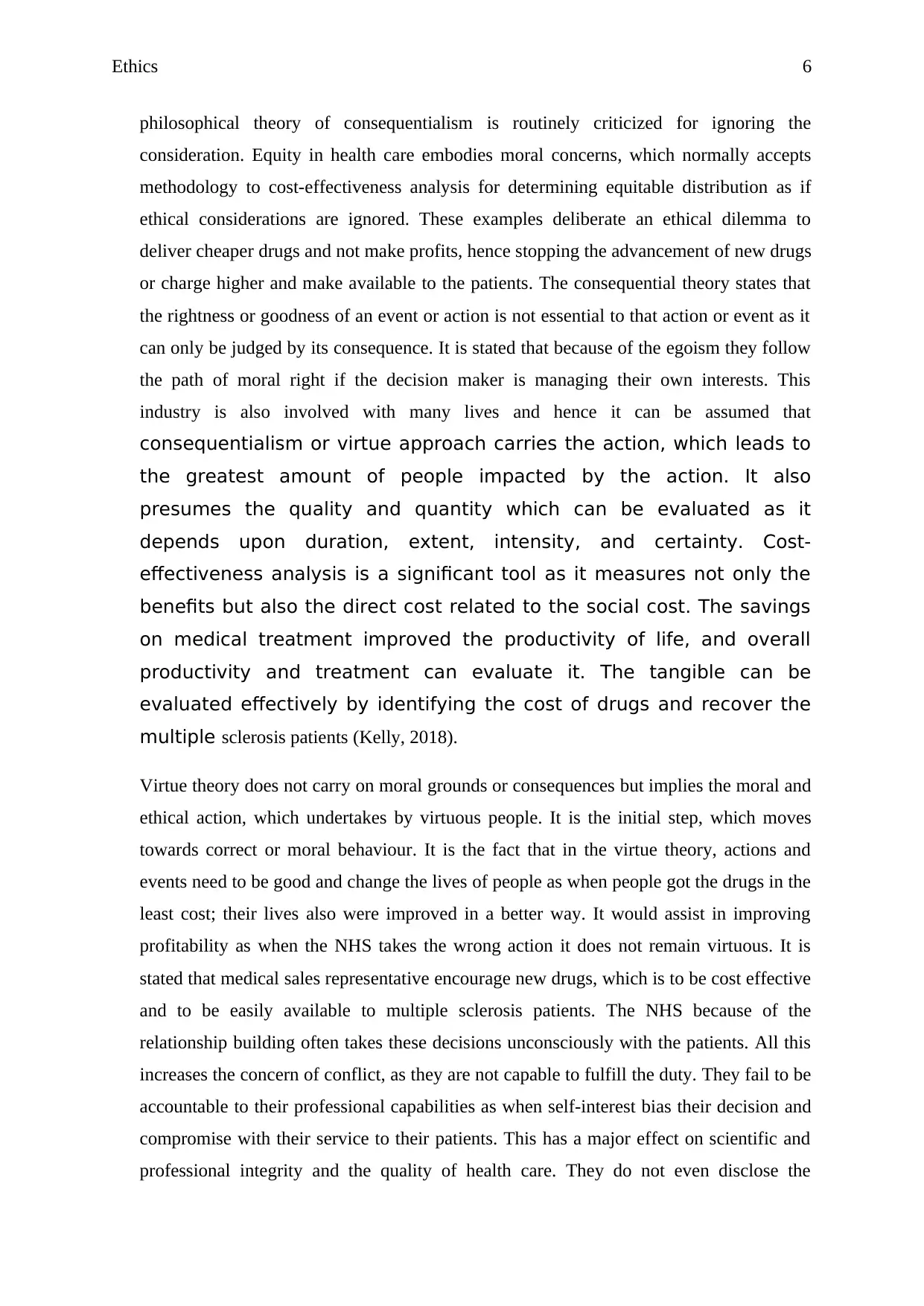
Ethics 6
philosophical theory of consequentialism is routinely criticized for ignoring the
consideration. Equity in health care embodies moral concerns, which normally accepts
methodology to cost-effectiveness analysis for determining equitable distribution as if
ethical considerations are ignored. These examples deliberate an ethical dilemma to
deliver cheaper drugs and not make profits, hence stopping the advancement of new drugs
or charge higher and make available to the patients. The consequential theory states that
the rightness or goodness of an event or action is not essential to that action or event as it
can only be judged by its consequence. It is stated that because of the egoism they follow
the path of moral right if the decision maker is managing their own interests. This
industry is also involved with many lives and hence it can be assumed that
consequentialism or virtue approach carries the action, which leads to
the greatest amount of people impacted by the action. It also
presumes the quality and quantity which can be evaluated as it
depends upon duration, extent, intensity, and certainty. Cost-
effectiveness analysis is a significant tool as it measures not only the
benefits but also the direct cost related to the social cost. The savings
on medical treatment improved the productivity of life, and overall
productivity and treatment can evaluate it. The tangible can be
evaluated effectively by identifying the cost of drugs and recover the
multiple sclerosis patients (Kelly, 2018).
Virtue theory does not carry on moral grounds or consequences but implies the moral and
ethical action, which undertakes by virtuous people. It is the initial step, which moves
towards correct or moral behaviour. It is the fact that in the virtue theory, actions and
events need to be good and change the lives of people as when people got the drugs in the
least cost; their lives also were improved in a better way. It would assist in improving
profitability as when the NHS takes the wrong action it does not remain virtuous. It is
stated that medical sales representative encourage new drugs, which is to be cost effective
and to be easily available to multiple sclerosis patients. The NHS because of the
relationship building often takes these decisions unconsciously with the patients. All this
increases the concern of conflict, as they are not capable to fulfill the duty. They fail to be
accountable to their professional capabilities as when self-interest bias their decision and
compromise with their service to their patients. This has a major effect on scientific and
professional integrity and the quality of health care. They do not even disclose the
philosophical theory of consequentialism is routinely criticized for ignoring the
consideration. Equity in health care embodies moral concerns, which normally accepts
methodology to cost-effectiveness analysis for determining equitable distribution as if
ethical considerations are ignored. These examples deliberate an ethical dilemma to
deliver cheaper drugs and not make profits, hence stopping the advancement of new drugs
or charge higher and make available to the patients. The consequential theory states that
the rightness or goodness of an event or action is not essential to that action or event as it
can only be judged by its consequence. It is stated that because of the egoism they follow
the path of moral right if the decision maker is managing their own interests. This
industry is also involved with many lives and hence it can be assumed that
consequentialism or virtue approach carries the action, which leads to
the greatest amount of people impacted by the action. It also
presumes the quality and quantity which can be evaluated as it
depends upon duration, extent, intensity, and certainty. Cost-
effectiveness analysis is a significant tool as it measures not only the
benefits but also the direct cost related to the social cost. The savings
on medical treatment improved the productivity of life, and overall
productivity and treatment can evaluate it. The tangible can be
evaluated effectively by identifying the cost of drugs and recover the
multiple sclerosis patients (Kelly, 2018).
Virtue theory does not carry on moral grounds or consequences but implies the moral and
ethical action, which undertakes by virtuous people. It is the initial step, which moves
towards correct or moral behaviour. It is the fact that in the virtue theory, actions and
events need to be good and change the lives of people as when people got the drugs in the
least cost; their lives also were improved in a better way. It would assist in improving
profitability as when the NHS takes the wrong action it does not remain virtuous. It is
stated that medical sales representative encourage new drugs, which is to be cost effective
and to be easily available to multiple sclerosis patients. The NHS because of the
relationship building often takes these decisions unconsciously with the patients. All this
increases the concern of conflict, as they are not capable to fulfill the duty. They fail to be
accountable to their professional capabilities as when self-interest bias their decision and
compromise with their service to their patients. This has a major effect on scientific and
professional integrity and the quality of health care. They do not even disclose the
Paraphrase This Document
Need a fresh take? Get an instant paraphrase of this document with our AI Paraphraser
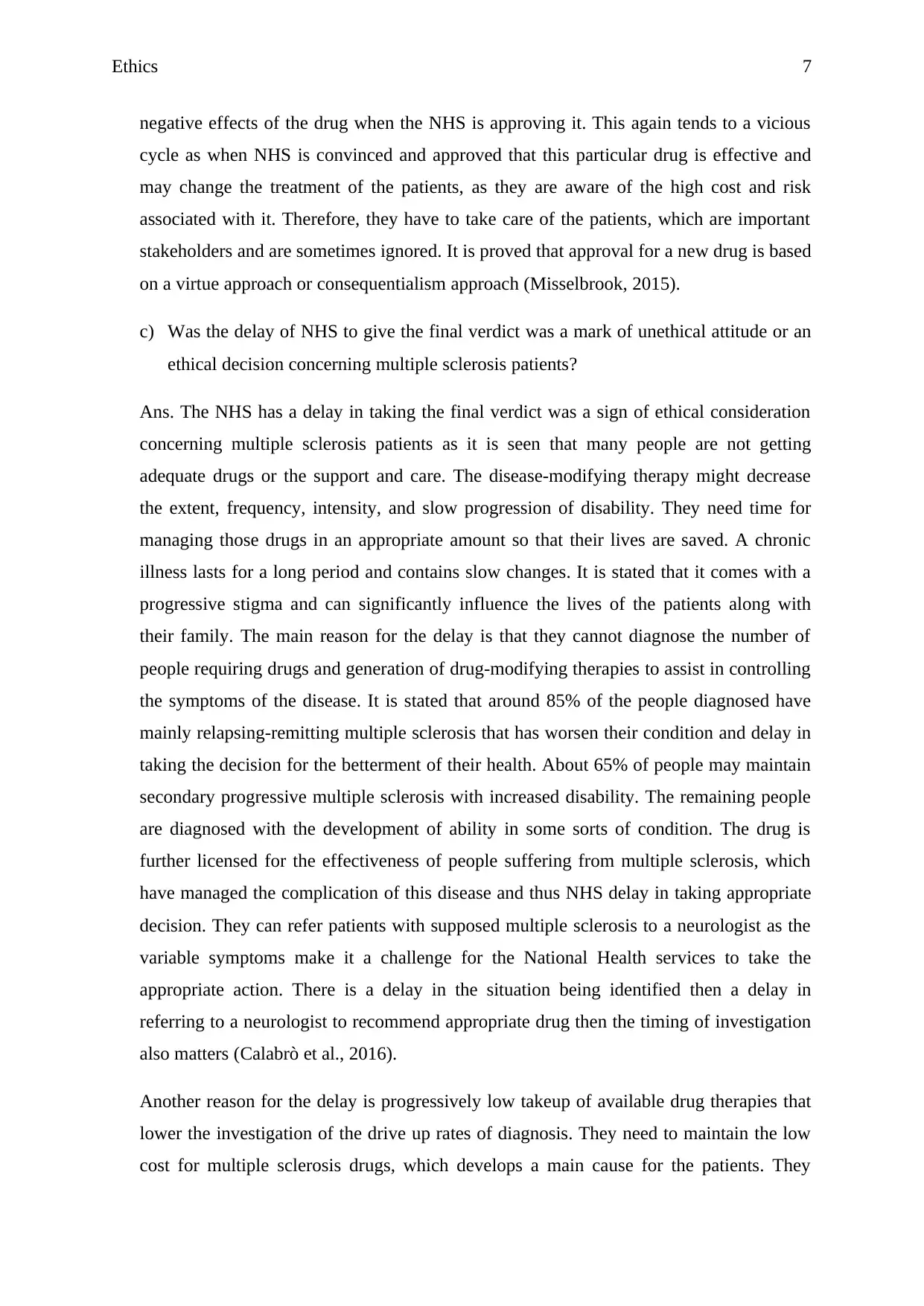
Ethics 7
negative effects of the drug when the NHS is approving it. This again tends to a vicious
cycle as when NHS is convinced and approved that this particular drug is effective and
may change the treatment of the patients, as they are aware of the high cost and risk
associated with it. Therefore, they have to take care of the patients, which are important
stakeholders and are sometimes ignored. It is proved that approval for a new drug is based
on a virtue approach or consequentialism approach (Misselbrook, 2015).
c) Was the delay of NHS to give the final verdict was a mark of unethical attitude or an
ethical decision concerning multiple sclerosis patients?
Ans. The NHS has a delay in taking the final verdict was a sign of ethical consideration
concerning multiple sclerosis patients as it is seen that many people are not getting
adequate drugs or the support and care. The disease-modifying therapy might decrease
the extent, frequency, intensity, and slow progression of disability. They need time for
managing those drugs in an appropriate amount so that their lives are saved. A chronic
illness lasts for a long period and contains slow changes. It is stated that it comes with a
progressive stigma and can significantly influence the lives of the patients along with
their family. The main reason for the delay is that they cannot diagnose the number of
people requiring drugs and generation of drug-modifying therapies to assist in controlling
the symptoms of the disease. It is stated that around 85% of the people diagnosed have
mainly relapsing-remitting multiple sclerosis that has worsen their condition and delay in
taking the decision for the betterment of their health. About 65% of people may maintain
secondary progressive multiple sclerosis with increased disability. The remaining people
are diagnosed with the development of ability in some sorts of condition. The drug is
further licensed for the effectiveness of people suffering from multiple sclerosis, which
have managed the complication of this disease and thus NHS delay in taking appropriate
decision. They can refer patients with supposed multiple sclerosis to a neurologist as the
variable symptoms make it a challenge for the National Health services to take the
appropriate action. There is a delay in the situation being identified then a delay in
referring to a neurologist to recommend appropriate drug then the timing of investigation
also matters (Calabrò et al., 2016).
Another reason for the delay is progressively low takeup of available drug therapies that
lower the investigation of the drive up rates of diagnosis. They need to maintain the low
cost for multiple sclerosis drugs, which develops a main cause for the patients. They
negative effects of the drug when the NHS is approving it. This again tends to a vicious
cycle as when NHS is convinced and approved that this particular drug is effective and
may change the treatment of the patients, as they are aware of the high cost and risk
associated with it. Therefore, they have to take care of the patients, which are important
stakeholders and are sometimes ignored. It is proved that approval for a new drug is based
on a virtue approach or consequentialism approach (Misselbrook, 2015).
c) Was the delay of NHS to give the final verdict was a mark of unethical attitude or an
ethical decision concerning multiple sclerosis patients?
Ans. The NHS has a delay in taking the final verdict was a sign of ethical consideration
concerning multiple sclerosis patients as it is seen that many people are not getting
adequate drugs or the support and care. The disease-modifying therapy might decrease
the extent, frequency, intensity, and slow progression of disability. They need time for
managing those drugs in an appropriate amount so that their lives are saved. A chronic
illness lasts for a long period and contains slow changes. It is stated that it comes with a
progressive stigma and can significantly influence the lives of the patients along with
their family. The main reason for the delay is that they cannot diagnose the number of
people requiring drugs and generation of drug-modifying therapies to assist in controlling
the symptoms of the disease. It is stated that around 85% of the people diagnosed have
mainly relapsing-remitting multiple sclerosis that has worsen their condition and delay in
taking the decision for the betterment of their health. About 65% of people may maintain
secondary progressive multiple sclerosis with increased disability. The remaining people
are diagnosed with the development of ability in some sorts of condition. The drug is
further licensed for the effectiveness of people suffering from multiple sclerosis, which
have managed the complication of this disease and thus NHS delay in taking appropriate
decision. They can refer patients with supposed multiple sclerosis to a neurologist as the
variable symptoms make it a challenge for the National Health services to take the
appropriate action. There is a delay in the situation being identified then a delay in
referring to a neurologist to recommend appropriate drug then the timing of investigation
also matters (Calabrò et al., 2016).
Another reason for the delay is progressively low takeup of available drug therapies that
lower the investigation of the drive up rates of diagnosis. They need to maintain the low
cost for multiple sclerosis drugs, which develops a main cause for the patients. They
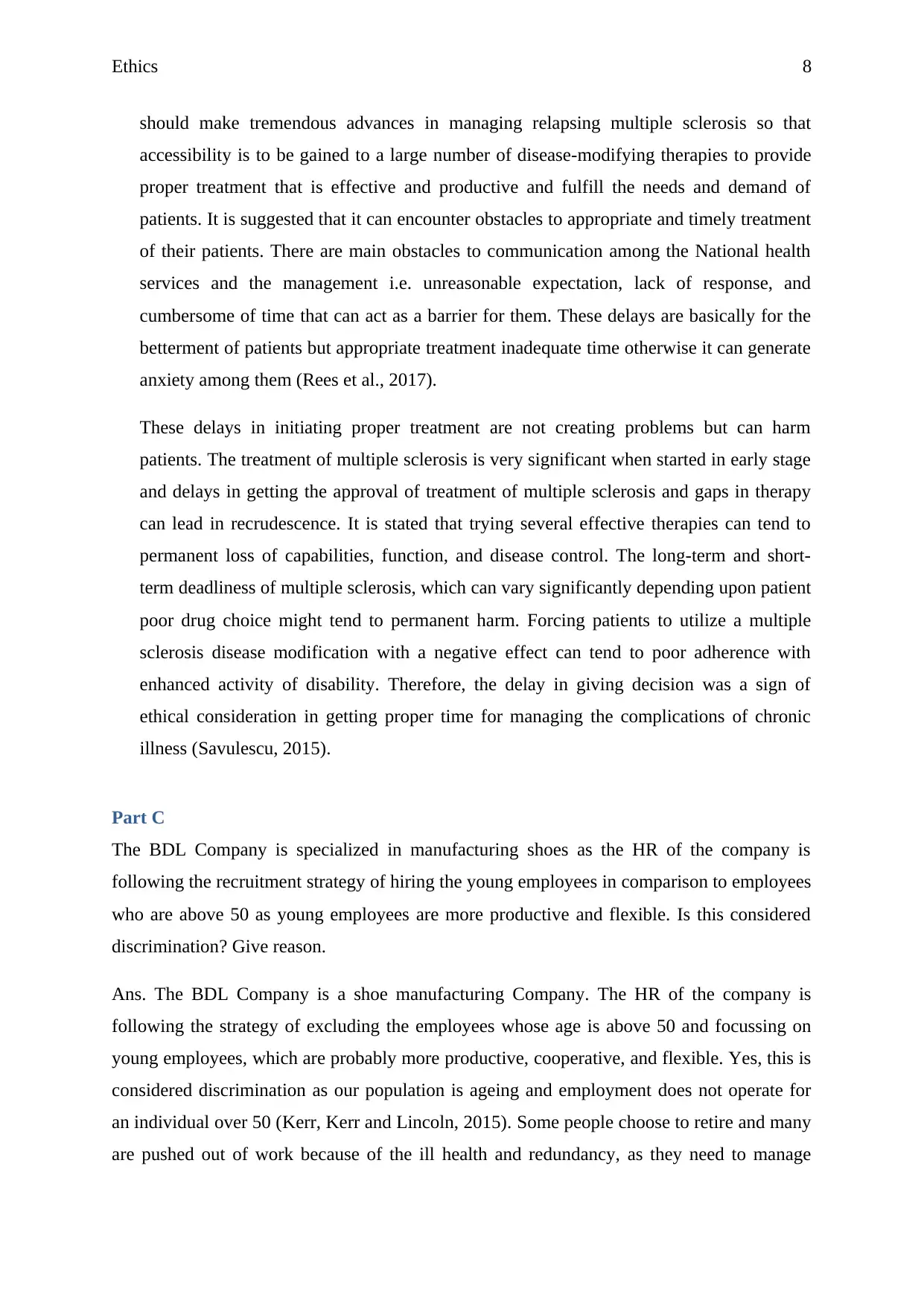
Ethics 8
should make tremendous advances in managing relapsing multiple sclerosis so that
accessibility is to be gained to a large number of disease-modifying therapies to provide
proper treatment that is effective and productive and fulfill the needs and demand of
patients. It is suggested that it can encounter obstacles to appropriate and timely treatment
of their patients. There are main obstacles to communication among the National health
services and the management i.e. unreasonable expectation, lack of response, and
cumbersome of time that can act as a barrier for them. These delays are basically for the
betterment of patients but appropriate treatment inadequate time otherwise it can generate
anxiety among them (Rees et al., 2017).
These delays in initiating proper treatment are not creating problems but can harm
patients. The treatment of multiple sclerosis is very significant when started in early stage
and delays in getting the approval of treatment of multiple sclerosis and gaps in therapy
can lead in recrudescence. It is stated that trying several effective therapies can tend to
permanent loss of capabilities, function, and disease control. The long-term and short-
term deadliness of multiple sclerosis, which can vary significantly depending upon patient
poor drug choice might tend to permanent harm. Forcing patients to utilize a multiple
sclerosis disease modification with a negative effect can tend to poor adherence with
enhanced activity of disability. Therefore, the delay in giving decision was a sign of
ethical consideration in getting proper time for managing the complications of chronic
illness (Savulescu, 2015).
Part C
The BDL Company is specialized in manufacturing shoes as the HR of the company is
following the recruitment strategy of hiring the young employees in comparison to employees
who are above 50 as young employees are more productive and flexible. Is this considered
discrimination? Give reason.
Ans. The BDL Company is a shoe manufacturing Company. The HR of the company is
following the strategy of excluding the employees whose age is above 50 and focussing on
young employees, which are probably more productive, cooperative, and flexible. Yes, this is
considered discrimination as our population is ageing and employment does not operate for
an individual over 50 (Kerr, Kerr and Lincoln, 2015). Some people choose to retire and many
are pushed out of work because of the ill health and redundancy, as they need to manage
should make tremendous advances in managing relapsing multiple sclerosis so that
accessibility is to be gained to a large number of disease-modifying therapies to provide
proper treatment that is effective and productive and fulfill the needs and demand of
patients. It is suggested that it can encounter obstacles to appropriate and timely treatment
of their patients. There are main obstacles to communication among the National health
services and the management i.e. unreasonable expectation, lack of response, and
cumbersome of time that can act as a barrier for them. These delays are basically for the
betterment of patients but appropriate treatment inadequate time otherwise it can generate
anxiety among them (Rees et al., 2017).
These delays in initiating proper treatment are not creating problems but can harm
patients. The treatment of multiple sclerosis is very significant when started in early stage
and delays in getting the approval of treatment of multiple sclerosis and gaps in therapy
can lead in recrudescence. It is stated that trying several effective therapies can tend to
permanent loss of capabilities, function, and disease control. The long-term and short-
term deadliness of multiple sclerosis, which can vary significantly depending upon patient
poor drug choice might tend to permanent harm. Forcing patients to utilize a multiple
sclerosis disease modification with a negative effect can tend to poor adherence with
enhanced activity of disability. Therefore, the delay in giving decision was a sign of
ethical consideration in getting proper time for managing the complications of chronic
illness (Savulescu, 2015).
Part C
The BDL Company is specialized in manufacturing shoes as the HR of the company is
following the recruitment strategy of hiring the young employees in comparison to employees
who are above 50 as young employees are more productive and flexible. Is this considered
discrimination? Give reason.
Ans. The BDL Company is a shoe manufacturing Company. The HR of the company is
following the strategy of excluding the employees whose age is above 50 and focussing on
young employees, which are probably more productive, cooperative, and flexible. Yes, this is
considered discrimination as our population is ageing and employment does not operate for
an individual over 50 (Kerr, Kerr and Lincoln, 2015). Some people choose to retire and many
are pushed out of work because of the ill health and redundancy, as they need to manage
⊘ This is a preview!⊘
Do you want full access?
Subscribe today to unlock all pages.

Trusted by 1+ million students worldwide
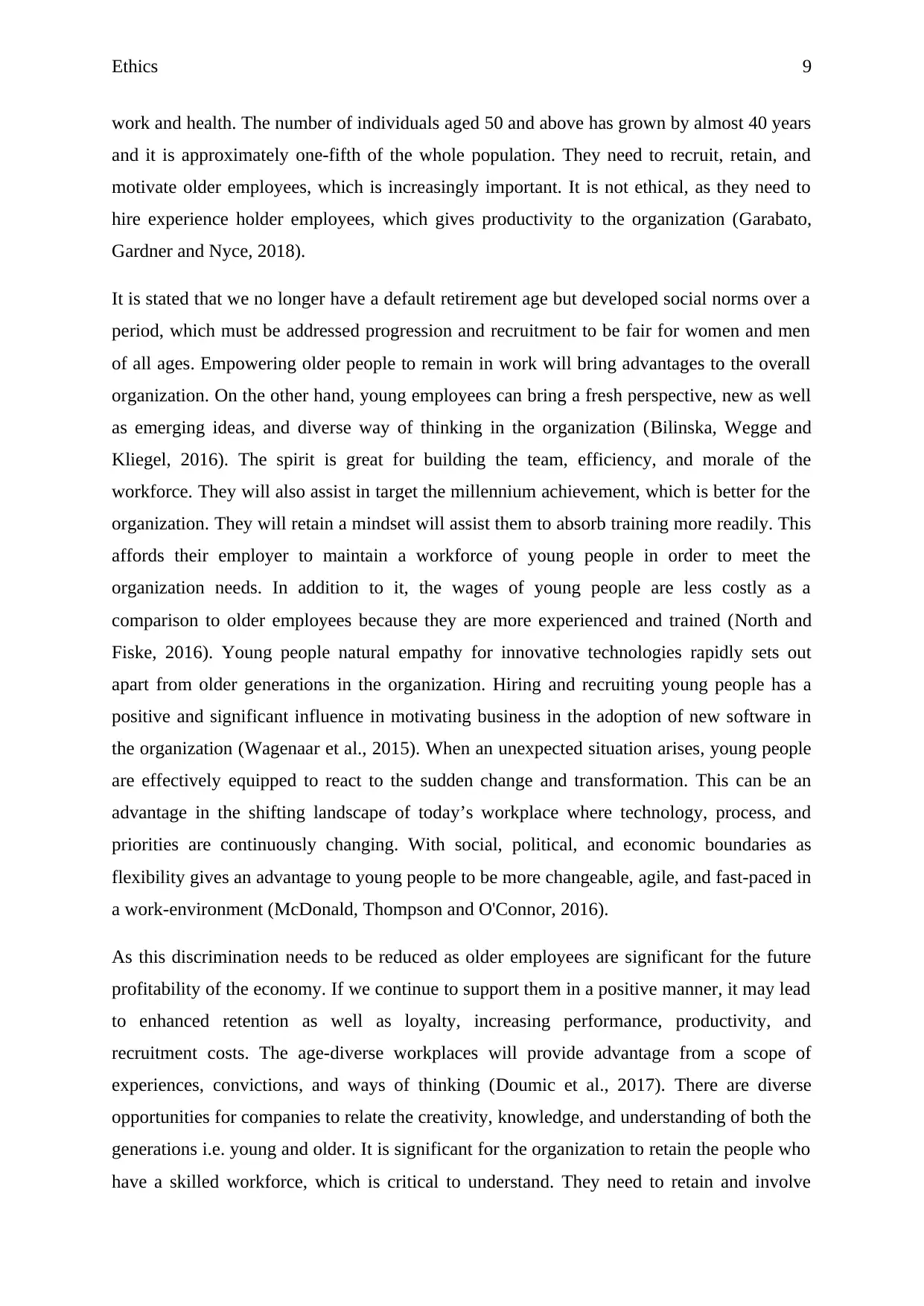
Ethics 9
work and health. The number of individuals aged 50 and above has grown by almost 40 years
and it is approximately one-fifth of the whole population. They need to recruit, retain, and
motivate older employees, which is increasingly important. It is not ethical, as they need to
hire experience holder employees, which gives productivity to the organization (Garabato,
Gardner and Nyce, 2018).
It is stated that we no longer have a default retirement age but developed social norms over a
period, which must be addressed progression and recruitment to be fair for women and men
of all ages. Empowering older people to remain in work will bring advantages to the overall
organization. On the other hand, young employees can bring a fresh perspective, new as well
as emerging ideas, and diverse way of thinking in the organization (Bilinska, Wegge and
Kliegel, 2016). The spirit is great for building the team, efficiency, and morale of the
workforce. They will also assist in target the millennium achievement, which is better for the
organization. They will retain a mindset will assist them to absorb training more readily. This
affords their employer to maintain a workforce of young people in order to meet the
organization needs. In addition to it, the wages of young people are less costly as a
comparison to older employees because they are more experienced and trained (North and
Fiske, 2016). Young people natural empathy for innovative technologies rapidly sets out
apart from older generations in the organization. Hiring and recruiting young people has a
positive and significant influence in motivating business in the adoption of new software in
the organization (Wagenaar et al., 2015). When an unexpected situation arises, young people
are effectively equipped to react to the sudden change and transformation. This can be an
advantage in the shifting landscape of today’s workplace where technology, process, and
priorities are continuously changing. With social, political, and economic boundaries as
flexibility gives an advantage to young people to be more changeable, agile, and fast-paced in
a work-environment (McDonald, Thompson and O'Connor, 2016).
As this discrimination needs to be reduced as older employees are significant for the future
profitability of the economy. If we continue to support them in a positive manner, it may lead
to enhanced retention as well as loyalty, increasing performance, productivity, and
recruitment costs. The age-diverse workplaces will provide advantage from a scope of
experiences, convictions, and ways of thinking (Doumic et al., 2017). There are diverse
opportunities for companies to relate the creativity, knowledge, and understanding of both the
generations i.e. young and older. It is significant for the organization to retain the people who
have a skilled workforce, which is critical to understand. They need to retain and involve
work and health. The number of individuals aged 50 and above has grown by almost 40 years
and it is approximately one-fifth of the whole population. They need to recruit, retain, and
motivate older employees, which is increasingly important. It is not ethical, as they need to
hire experience holder employees, which gives productivity to the organization (Garabato,
Gardner and Nyce, 2018).
It is stated that we no longer have a default retirement age but developed social norms over a
period, which must be addressed progression and recruitment to be fair for women and men
of all ages. Empowering older people to remain in work will bring advantages to the overall
organization. On the other hand, young employees can bring a fresh perspective, new as well
as emerging ideas, and diverse way of thinking in the organization (Bilinska, Wegge and
Kliegel, 2016). The spirit is great for building the team, efficiency, and morale of the
workforce. They will also assist in target the millennium achievement, which is better for the
organization. They will retain a mindset will assist them to absorb training more readily. This
affords their employer to maintain a workforce of young people in order to meet the
organization needs. In addition to it, the wages of young people are less costly as a
comparison to older employees because they are more experienced and trained (North and
Fiske, 2016). Young people natural empathy for innovative technologies rapidly sets out
apart from older generations in the organization. Hiring and recruiting young people has a
positive and significant influence in motivating business in the adoption of new software in
the organization (Wagenaar et al., 2015). When an unexpected situation arises, young people
are effectively equipped to react to the sudden change and transformation. This can be an
advantage in the shifting landscape of today’s workplace where technology, process, and
priorities are continuously changing. With social, political, and economic boundaries as
flexibility gives an advantage to young people to be more changeable, agile, and fast-paced in
a work-environment (McDonald, Thompson and O'Connor, 2016).
As this discrimination needs to be reduced as older employees are significant for the future
profitability of the economy. If we continue to support them in a positive manner, it may lead
to enhanced retention as well as loyalty, increasing performance, productivity, and
recruitment costs. The age-diverse workplaces will provide advantage from a scope of
experiences, convictions, and ways of thinking (Doumic et al., 2017). There are diverse
opportunities for companies to relate the creativity, knowledge, and understanding of both the
generations i.e. young and older. It is significant for the organization to retain the people who
have a skilled workforce, which is critical to understand. They need to retain and involve
Paraphrase This Document
Need a fresh take? Get an instant paraphrase of this document with our AI Paraphraser
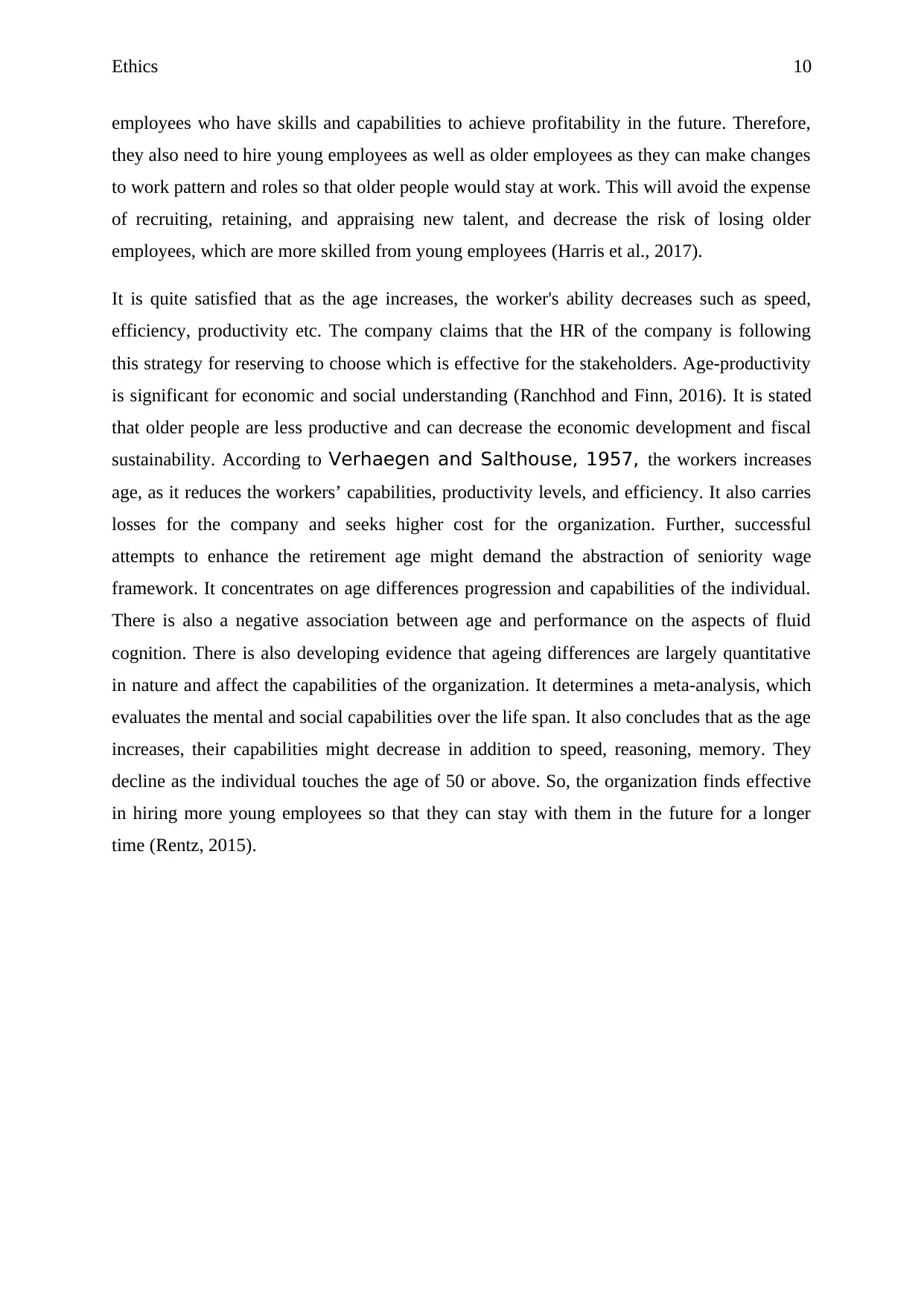
Ethics 10
employees who have skills and capabilities to achieve profitability in the future. Therefore,
they also need to hire young employees as well as older employees as they can make changes
to work pattern and roles so that older people would stay at work. This will avoid the expense
of recruiting, retaining, and appraising new talent, and decrease the risk of losing older
employees, which are more skilled from young employees (Harris et al., 2017).
It is quite satisfied that as the age increases, the worker's ability decreases such as speed,
efficiency, productivity etc. The company claims that the HR of the company is following
this strategy for reserving to choose which is effective for the stakeholders. Age-productivity
is significant for economic and social understanding (Ranchhod and Finn, 2016). It is stated
that older people are less productive and can decrease the economic development and fiscal
sustainability. According to Verhaegen and Salthouse, 1957, the workers increases
age, as it reduces the workers’ capabilities, productivity levels, and efficiency. It also carries
losses for the company and seeks higher cost for the organization. Further, successful
attempts to enhance the retirement age might demand the abstraction of seniority wage
framework. It concentrates on age differences progression and capabilities of the individual.
There is also a negative association between age and performance on the aspects of fluid
cognition. There is also developing evidence that ageing differences are largely quantitative
in nature and affect the capabilities of the organization. It determines a meta-analysis, which
evaluates the mental and social capabilities over the life span. It also concludes that as the age
increases, their capabilities might decrease in addition to speed, reasoning, memory. They
decline as the individual touches the age of 50 or above. So, the organization finds effective
in hiring more young employees so that they can stay with them in the future for a longer
time (Rentz, 2015).
employees who have skills and capabilities to achieve profitability in the future. Therefore,
they also need to hire young employees as well as older employees as they can make changes
to work pattern and roles so that older people would stay at work. This will avoid the expense
of recruiting, retaining, and appraising new talent, and decrease the risk of losing older
employees, which are more skilled from young employees (Harris et al., 2017).
It is quite satisfied that as the age increases, the worker's ability decreases such as speed,
efficiency, productivity etc. The company claims that the HR of the company is following
this strategy for reserving to choose which is effective for the stakeholders. Age-productivity
is significant for economic and social understanding (Ranchhod and Finn, 2016). It is stated
that older people are less productive and can decrease the economic development and fiscal
sustainability. According to Verhaegen and Salthouse, 1957, the workers increases
age, as it reduces the workers’ capabilities, productivity levels, and efficiency. It also carries
losses for the company and seeks higher cost for the organization. Further, successful
attempts to enhance the retirement age might demand the abstraction of seniority wage
framework. It concentrates on age differences progression and capabilities of the individual.
There is also a negative association between age and performance on the aspects of fluid
cognition. There is also developing evidence that ageing differences are largely quantitative
in nature and affect the capabilities of the organization. It determines a meta-analysis, which
evaluates the mental and social capabilities over the life span. It also concludes that as the age
increases, their capabilities might decrease in addition to speed, reasoning, memory. They
decline as the individual touches the age of 50 or above. So, the organization finds effective
in hiring more young employees so that they can stay with them in the future for a longer
time (Rentz, 2015).
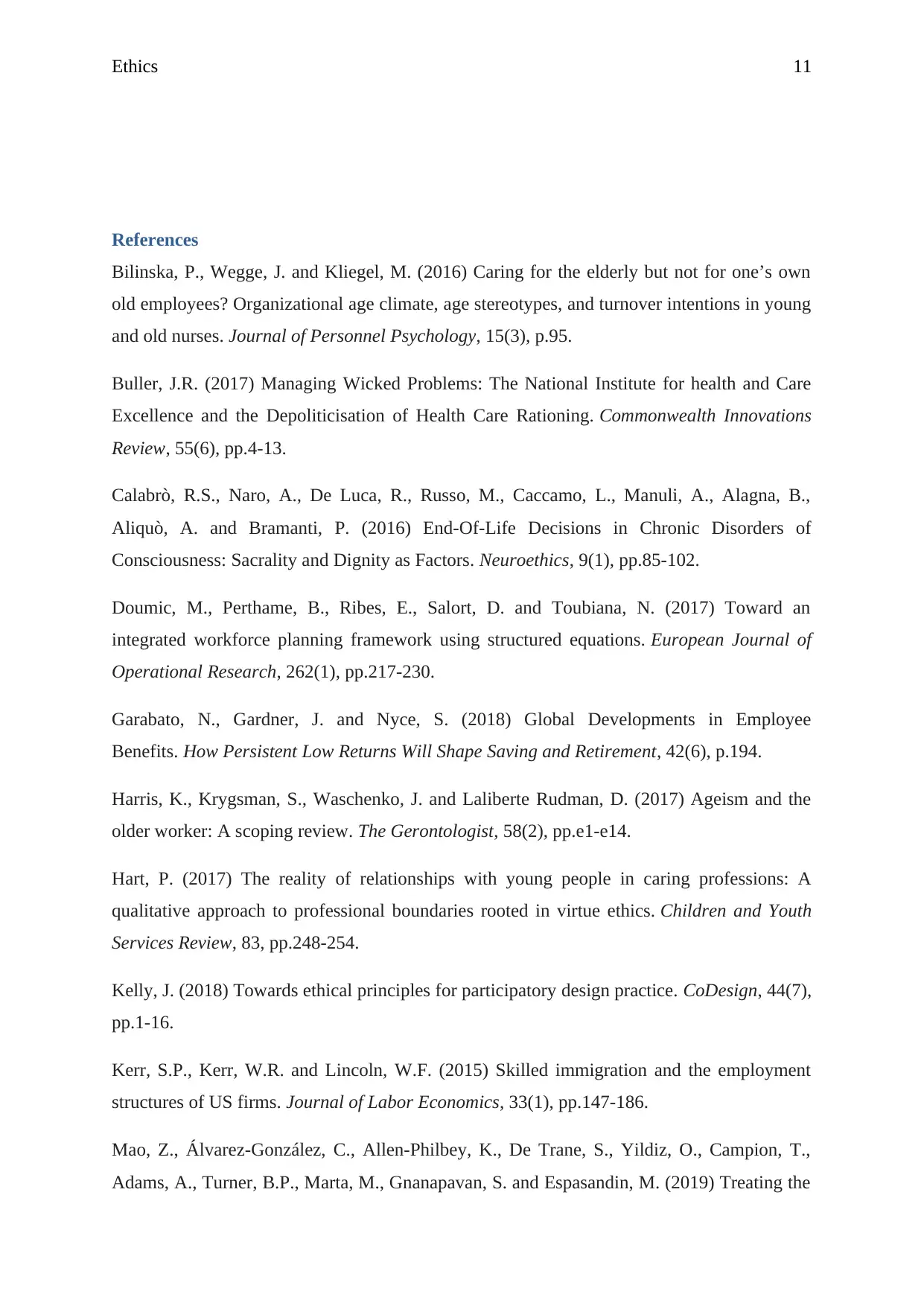
Ethics 11
References
Bilinska, P., Wegge, J. and Kliegel, M. (2016) Caring for the elderly but not for one’s own
old employees? Organizational age climate, age stereotypes, and turnover intentions in young
and old nurses. Journal of Personnel Psychology, 15(3), p.95.
Buller, J.R. (2017) Managing Wicked Problems: The National Institute for health and Care
Excellence and the Depoliticisation of Health Care Rationing. Commonwealth Innovations
Review, 55(6), pp.4-13.
Calabrò, R.S., Naro, A., De Luca, R., Russo, M., Caccamo, L., Manuli, A., Alagna, B.,
Aliquò, A. and Bramanti, P. (2016) End-Of-Life Decisions in Chronic Disorders of
Consciousness: Sacrality and Dignity as Factors. Neuroethics, 9(1), pp.85-102.
Doumic, M., Perthame, B., Ribes, E., Salort, D. and Toubiana, N. (2017) Toward an
integrated workforce planning framework using structured equations. European Journal of
Operational Research, 262(1), pp.217-230.
Garabato, N., Gardner, J. and Nyce, S. (2018) Global Developments in Employee
Benefits. How Persistent Low Returns Will Shape Saving and Retirement, 42(6), p.194.
Harris, K., Krygsman, S., Waschenko, J. and Laliberte Rudman, D. (2017) Ageism and the
older worker: A scoping review. The Gerontologist, 58(2), pp.e1-e14.
Hart, P. (2017) The reality of relationships with young people in caring professions: A
qualitative approach to professional boundaries rooted in virtue ethics. Children and Youth
Services Review, 83, pp.248-254.
Kelly, J. (2018) Towards ethical principles for participatory design practice. CoDesign, 44(7),
pp.1-16.
Kerr, S.P., Kerr, W.R. and Lincoln, W.F. (2015) Skilled immigration and the employment
structures of US firms. Journal of Labor Economics, 33(1), pp.147-186.
Mao, Z., Álvarez-González, C., Allen-Philbey, K., De Trane, S., Yildiz, O., Campion, T.,
Adams, A., Turner, B.P., Marta, M., Gnanapavan, S. and Espasandin, M. (2019) Treating the
References
Bilinska, P., Wegge, J. and Kliegel, M. (2016) Caring for the elderly but not for one’s own
old employees? Organizational age climate, age stereotypes, and turnover intentions in young
and old nurses. Journal of Personnel Psychology, 15(3), p.95.
Buller, J.R. (2017) Managing Wicked Problems: The National Institute for health and Care
Excellence and the Depoliticisation of Health Care Rationing. Commonwealth Innovations
Review, 55(6), pp.4-13.
Calabrò, R.S., Naro, A., De Luca, R., Russo, M., Caccamo, L., Manuli, A., Alagna, B.,
Aliquò, A. and Bramanti, P. (2016) End-Of-Life Decisions in Chronic Disorders of
Consciousness: Sacrality and Dignity as Factors. Neuroethics, 9(1), pp.85-102.
Doumic, M., Perthame, B., Ribes, E., Salort, D. and Toubiana, N. (2017) Toward an
integrated workforce planning framework using structured equations. European Journal of
Operational Research, 262(1), pp.217-230.
Garabato, N., Gardner, J. and Nyce, S. (2018) Global Developments in Employee
Benefits. How Persistent Low Returns Will Shape Saving and Retirement, 42(6), p.194.
Harris, K., Krygsman, S., Waschenko, J. and Laliberte Rudman, D. (2017) Ageism and the
older worker: A scoping review. The Gerontologist, 58(2), pp.e1-e14.
Hart, P. (2017) The reality of relationships with young people in caring professions: A
qualitative approach to professional boundaries rooted in virtue ethics. Children and Youth
Services Review, 83, pp.248-254.
Kelly, J. (2018) Towards ethical principles for participatory design practice. CoDesign, 44(7),
pp.1-16.
Kerr, S.P., Kerr, W.R. and Lincoln, W.F. (2015) Skilled immigration and the employment
structures of US firms. Journal of Labor Economics, 33(1), pp.147-186.
Mao, Z., Álvarez-González, C., Allen-Philbey, K., De Trane, S., Yildiz, O., Campion, T.,
Adams, A., Turner, B.P., Marta, M., Gnanapavan, S. and Espasandin, M. (2019) Treating the
⊘ This is a preview!⊘
Do you want full access?
Subscribe today to unlock all pages.

Trusted by 1+ million students worldwide
1 out of 14
Related Documents
Your All-in-One AI-Powered Toolkit for Academic Success.
+13062052269
info@desklib.com
Available 24*7 on WhatsApp / Email
![[object Object]](/_next/static/media/star-bottom.7253800d.svg)
Unlock your academic potential
Copyright © 2020–2025 A2Z Services. All Rights Reserved. Developed and managed by ZUCOL.





